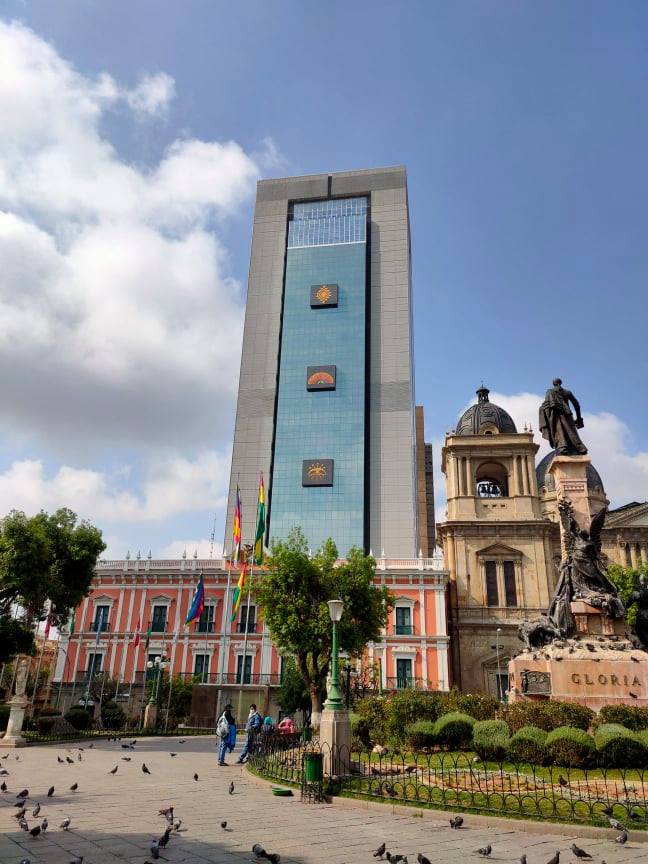
El pasado 06 de enero se emitió el Decreto Supremo N°4857, por medio del cual se establece la estructura organizativa del Órgano Ejecutivo del Estado Plurinacional y las atribuciones de la/el Presidenta(e), Vicepresidenta(e) y de las Ministras y Ministros. La elaboración del citado decreto responde a la necesidad de contar con un instrumento legal que compile lo establecido en el Decreto Supremo N°29894 y las múltiples modificaciones que ha sufrido el mismo con el paso del tiempo, incorporando algunos cambios en cuanto a las denominaciones y la adhesión de atribuciones a ministerios, viceministerios y direcciones, además de modificar la autoridad encargada de resolver el recurso jerárquico a ser presentado por la Autoridad de Fiscalización y Control Social de Bosques y Tierra, que antes era la/el Ministra(o) de Desarrollo Rural y Tierras y con la modificación sería la/el Ministra(o) de Medio Ambiente y Agua.
Algunas incorporaciones de las modificaciones efectuadas en los últimos años son la eliminación de los siguientes Ministerios:
- Ministerio de Transparencia Institucional y Lucha Contra la Corrupción (se incorpora al Ministerio de Justicia mediante el DS N°3058 del 22 de enero de 2017)
- Ministerio de Autonomía (se fusiona al Ministerio de la Presidencia por medio del DS Nº3058)
Por otro lado, se puede advertir que en esta nueva norma se está dando mucho énfasis a algunas áreas que precisan mayor atención por la coyuntura y los cambios de la realidad que se han presentado en los últimos años, aspectos que naturalmente no estaban presentes en el Decreto Supremo N°29894 o que estaban de manera superficial. De tal manera, se destacan las siguientes áreas sobre las cuales se han establecido nuevas atribuciones a los ministerios de cada sector:
- Economía
- Lucha contra el contrabando;
- Promoción de inversiones privadas y extranjeras en los distintos sectores;
- Exportaciones de bienes con valor agregado y servicios;
- Economía circular para el desarrollo de la industria;
- Derecho de Bolivia al Libre Tránsito de mercancías;
- Apertura de mercados para la producción Hecho en Bolivia;
- Desarrollo turístico sostenible; y
- Aprovechamiento estatal de los minerales tecnológicos y tierras raras.
- Energía
- Transición energética.
- Recursos evaporíticos.
- Tecnología nuclear.
- Energías geotérmicas.
- Nuevas tecnologías energéticas.
- Energías renovables y no renovables, sustitutivas y complementarias.
- Tecnología e innovación
- Gobierno Electrónico y/o Digital y de Tecnologías de Información y Comunicación para el sector público del Estado Plurinacional.
- Investigación científica, tecnológica e innovación en el ámbito de medio amiente y agua, servicios financieros y desarrollo de la industria.
- Implementación de tecnologías espaciales y de nuevas tecnologías en las unidades económicas rurales.
- Formación de acuerdo con las tendencias educativas tecnológicas y digitales.
- Pueblos Indígenas, Originarios y Campesinos
- Identificación, prevención, protección y fortalecimiento de las naciones y PIOC en situación de alta vulnerabilidad.
- Salud
- Prevenir y contener la propagación de las enfermedades transmisibles y no transmisibles.
- Situaciones de desastres, crisis sanitaria y emergencia epidemiológica.
- Acceso universal y gratuito a servicios de salud.
- Medio ambiente
- Desarrollo forestal.
- Agua potable y alcantarillado sanitario para distintas jurisdicciones territoriales.
- Gestión integral de riego eficiente con enfoque de cuencas y climáticamente resiliente.
- Aprovechamiento sustentable y equitativo de los recursos maderables y no maderables del bosque.
- Incremento de la cobertura boscosa.
- Derechos de la Madre Tierra, el cambio climático, la biodiversidad, los bosques, el agua y el medio ambiente.
- Culturas, Descolonización y Despatriarcalización
- Políticas para la descolonización y despatriarcalización.
- Reconocimiento de la propiedad de los bienes culturales colectivos y comunitario del Estado Plurinacional.
Es así como, con lo anteriormente mencionado, es evidente que el Estado Boliviano busca responder a las demandas de interés actual incorporado atribuciones específicas a las distintas autoridades. Siendo, por ejemplo, necesario delegar competencias surgidas a raíz del COVID – 19, el cambio climático, la situación económica actual y la necesidad de adecuarse a las tendencias tecnológicas y digitales, entre otras. Metas que en su mayoría están alineadas con los Objetivos de Desarrollo Sostenible (ODS) fijados en 2015, tales como el objetivo 5 que impulsa a garantizar la disponibilidad de agua, su gestión sostenible y el saneamiento; el objetivo 7 que refiere a la Energía asequible y no contaminante; el objetivo 12 que versa sobre la Producción y consumo responsable; y el objetivo 15 que exhorta a gestionar sosteniblemente los bosques.
Finalmente, a efectos comparativos, cabe mencionar que la anterior norma que modificó la estructura del órgano ejecutivo boliviano, el DS N°29894 del 7 de febrero de 2009, realizó cambios profundos y estructurales como la extinción del Sistema de Regulación Sectorial (SIRESE) y la creación de ministerios que no existían a la fecha; mientras que en el caso de la norma vigente, el Decreto Supremo N°4857, se limita meramente a recopilar las modificaciones realizadas a nivel organizativo a lo largo de estos años, sin hacer cambios de mayor relevancia.